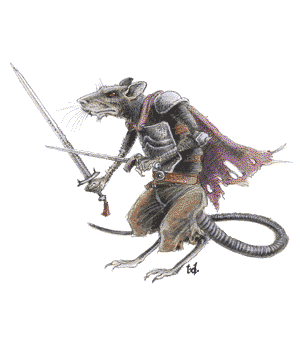| Climate/Terrain: | Any |

|
| Frequency: | Uncommon | |
| Organization: | Pack | |
| Activity Cycle: | Nocturnal | |
| Diet: | Scavenger | |
| Intelligence: | Very (11-12) | |
| Treasure: | C | |
| Alignment: | Lawful evil | |
| No. Appearing: | 4-24 (4d6) | |
| Armor Class: | 6 | |
| Movement: | 12 | |
| Hit Dice: | 3+1 | |
| THAC0: | 17 | |
| No. of Attacks: | 1 | |
| Damage/Attack: | By weapon | |
| Special Attacks: | Nil | |
| Special Defenses: | Hit only by silver or +1 or better weapons | |
| Magic Resistance: | Nil | |
| Size: | S-M (3'-6') | |
| Morale: | Steady (11-12) | |
| XP Value: | 270 |
Wererats, also called ratmen, are humans who can transform themselves into three forms -- human, human-sized ratman, and giant rat. They are sly and evil, and usually inhabit tunnel complexes beneath cities.
The wererat's human form tends to be a thin, wiry individual of shorter than average height. His eyes constantly dart around, and his nose and mouth may twitch if he is excited. Males often have thin, ragged moustaches.
The ratman form is somewhat shorter than the human form. The head, torso, and tail are identical to those of a rat, but the limbs remain human.
The third form is that of a giant rat 2 feet from nose to rump. This form is identical to that of the giant rat (q.v.). This is the preferred form for travel and spying on potential victims.
Wererats are often followed by 1-6 mice or rats that are instinctively drawn to them but are not controlled by them.
Combat: In all three forms, wererats rely on weapons for their attacks, preferring shortswords and daggers. Anyone who is injured by a true wererat has a 1% chance per point of damage of becoming a wererat. In their ratman and giant rat forms, wererats can be hurt only by silver or magical weapons.
Wererats prefer to attack from ambush. A favorite tactic is to assume human shape and lure unsuspecting victims into a trap. This is the only time wererats are voluntarily alone. Victims are then robbed, held for ransom, or eaten.
Each wererat is able to summon and control 2-12 giant rats.
Habitat/Society: Wererats live in packs, regardless of form, never being alone if they can help it. Solitary wererats are either sole survivors or engaged in mischief. They do not form interpersonal bonds like love or marriage. In fact, wererats rarely mate with their own kind. Offspring of a wererat and a human woman are human, although they are small, like their fathers. Offspring of a female wererat resemble giant rats with human-like paws. These ratlings grow to maturity in two years and gain the ability to transform themselves into human children with an apparent age about three times that of the ratling's actual age.
Wererats prefer subterranean lairs hidden among the sewers and catacombs beneath cities. Nothing can pass through the sewers and escape their attention. Unfortunately for the wererat, the sewer's stains and smells do not vanish when it assumes human form. This effectively limits wererats to the less savory sections of town as well as reducing the number of humans who might unknowingly mate with a wererat.
Wererats see cities as their hunting grounds. They delight in matching their superior intellects and meager physical skills against the more powerful and numerous humans. But they are no fools; they will not attack unless they are sure they can win. If a battle is going against them, wererats will scatter, transform to rat form, and head for the sanctuary of the sewers. They won't even defend their own lairs. Their attitude is that since they had stolen most of their belongings in the first place, they can always replace them.
Wererats are greedy and collect anything they think might have worth. The resulting trove usually has more junk than treasure, but a thorough search may reveal a wide variety of valuables.
Wererats frequent sleazy taverns, both for the cheap alcohol and to follow drunks into the streets to drag them away for the next day's meal.
Ecology: Wererats are parasites. They recognize that they are physically weaker than most species that dominate the surface. They have found and exploited the one niche where they have a chance to dominate, the world beneath the cities. They feed on humans and steal their riches. Humans unknowingly protect the wererats from both surface dwelling creatures and those who might burrow up from far below. Besides, the humans pay for the upkeep of the wererat's sewer realm.
Psychologically, wererats remind humans that no matter how strongly defended they think they are, monsters can still get in. Mothers describe wererats as bogeymen to scare unruly children.
| Previous Index Next | Cover Up |
Сайт создан в системе uCoz